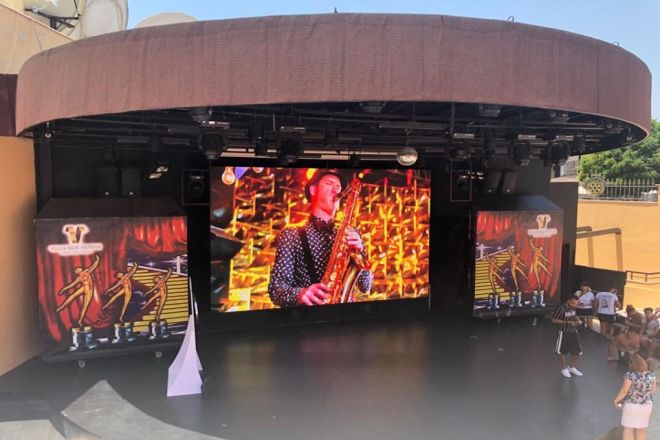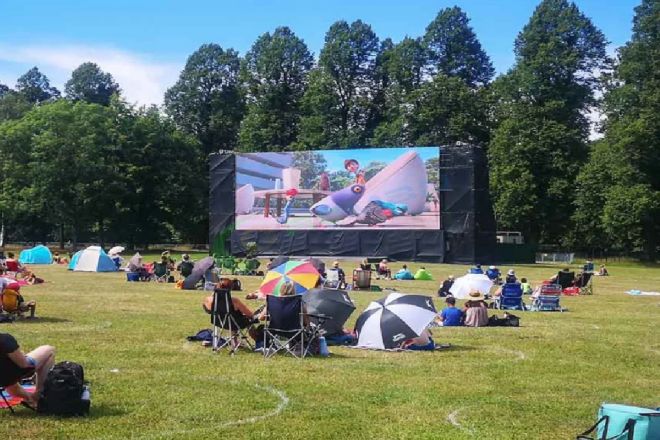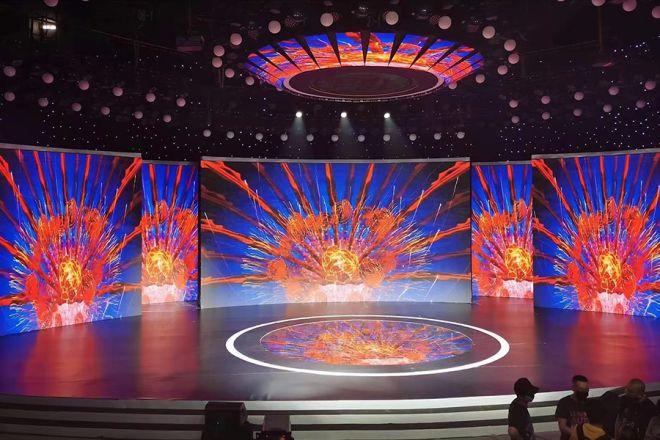Introduction

With the rapid development of science and technology and the advent of the digital era, the LED display industry is facing unprecedented development opportunities. As an important part of the digital display field, LED display screens are widely used in advertising, stage performances, sports venues, traffic instructions, and other fields. They have significant advantages such as high brightness, high definition, and long life.
In 2024, the LED display industry will continue to maintain strong momentum of development, with new developments in technological innovation, product upgrades, and market demand expansion.
1. Technological innovation and product upgrading
1). Maturity and application of new display technologies
- Technological breakthrough:
In recent years, the LED display industry has experienced significant technological changes. New display technologies such as micro-pitch LED, transparent LED, and flexible LED continue to make breakthroughs and begin to show their unique advantages in practical applications.
- Micro-pitch LED:
With the rapid increase in packaging yield, pass-through rate, and cost reduction, the market penetration rate of micro-pitch LED displays has increased significantly. This technology is widely used in e-sports venues, security monitoring, and other fields due to its characteristics of high definition, high brightness, and high color saturation.
- Transparent LED:
Transparent LED displays are favored in commercial advertising, exhibition displays, stage backgrounds, and other fields for their high definition, high brightness, and high light transmittance. With the advancement of technology, transparent LED displays will become larger, thinner, and more energy-efficient.
The emergence of flexible LED displays has brought new possibilities to the LED display industry. Its bendable and foldable features make LED displays more flexible in shape and size, providing more space for creative design.
Market impact: The maturity and application of new display technology not only improves the display effect and user experience of LED displays but also provides the possibility for its application in more fields. It is expected that these new display technologies will continue to promote the development of the LED display industry in the next few years.
2). Integration of intelligence and Internet
- Technology integration:
The deep integration of LED display screens with the Internet of Things, cloud computing, big data, and other technologies is becoming a new trend in industry development. This integration enables the LED display to have functions such as remote control, intelligent diagnosis, and content cloud updating.
- Remote control:
Through a network connection, users can remotely monitor and manage the LED display. This function not only improves usage efficiency but also reduces operation and maintenance costs.
- Intelligent diagnosis:
Through the intelligent diagnosis system, the LED display can automatically detect faults and provide early warning. This greatly reduces the number of human interventions and improves the efficiency of troubleshooting.
- Content cloud update:
Using cloud computing and big data technology, users can remotely update and manage the content of LED display screens. This function makes the application of LED display screens in advertising, information release, and other fields more flexible and convenient.
3). Satisfying customized needs
- Customized services:
With the diversification of market demands, the demand for customized LED displays has become increasingly prominent. The company provides customized services ranging from size, resolution, and installation methods to functional configuration based on the actual needs of customers.
- Market value:
Customized services bring more business opportunities to enterprises. By meeting the personalized needs of customers, companies can establish closer customer relationships and enhance brand influence and market competitiveness.
- Solution:
In order to meet customers’ customized needs, companies need to strengthen R&D capabilities and technological innovation. By continuously developing new technologies and products, companies can provide customers with more personalized and professional solutions. At the same time, companies also need to strengthen communication and cooperation with customers to ensure that solutions can truly meet customer needs.
2. Market demand and application scenario expansion

1). Expansion of the indoor and outdoor advertising market
- Advantages of LED display screens in the digital and intelligent advertising market:
LED display screens have become the first choice in the indoor and outdoor advertising market due to their high definition, high brightness, dynamic display, and other characteristics.
The integration of digital and intelligent technologies enables LED displays to realize functions such as real-time updating of advertising content and remote control, which greatly enhances the attractiveness and communication effect of advertising.
- Market opportunities brought about by the combination of creative advertising forms and LED displays:
The creative application forms of LED displays are becoming increasingly rich, such as 3D three-dimensional advertising, interactive advertising, etc., providing advertisers with more creative space.
Creative advertising combined with LED displays can attract more consumer attention and enhance brand image and market competitiveness.
2). Applications in stage performances and sports venues
- Applications of LED display screens in stage backgrounds, lighting special effects, event live broadcasts, etc.:
In stage performances, the LED display screen serves as a background screen, which can present colorful visual effects and bring a shocking audio-visual experience to the audience.
In stadiums, LED displays are not only used to display game information, player introductions, etc. but can also play game replays, highlights, etc., providing audiences with a comprehensive viewing experience.
- Features such as high brightness, high contrast, and high definition provide the audience with the following visual experience:
The high brightness of the LED display ensures that the audience can clearly see the screen content, even in dark performances or competition venues.
High contrast and high definition ensure the delicacy and realism of images and videos, bringing a more realistic visual enjoyment to the audience.
3). Traffic instructions and information release
- The role of LED display screens in traffic instructions and public information release:
LED displays can display traffic information, traffic signals, etc., in real-time on highways, urban roads, and other important traffic thoroughfares, providing drivers with important driving guidance.
In public places such as airports and stations, LED displays can publish flight information, public notices, etc. to facilitate passengers to obtain the information they need.
- How to use LED displays to improve the level of urban informatization:
By integrating various urban information resources and using LED displays for centralized display and release, the dissemination efficiency and coverage of urban information can be improved.
The remote control and intelligent diagnosis functions of the LED display make information release more flexible and convenient while also reducing maintenance costs.
Combined with the Internet of Things and big data technology, LED displays can also realize more intelligent applications, such as environmental monitoring, emergency command, etc., further improving the level of urban informatization.
3. Industry trends and market competition
1). The rise of LED small-pitch displays
- Technology comparison and market trends:
LED small-pitch display screens are gradually emerging in the market due to their high density and high resolution. Compared with LCD splicing screens, LED small-pitch displays have significant advantages in color saturation, contrast, and viewing angles.
With the continuous advancement of technology and the gradual reduction of costs, the market penetration rate of LED small-pitch displays will continue to increase, especially in fields such as security monitoring and radio and television studios, and its application prospects are broad.
- Advantage analysis:
The LED small-pitch display screen has a small pixel pitch and high pixel density, which can present a more delicate and clear image effect.
In the field of security monitoring, the high definition and brightness of LED small-pitch displays can ensure the clarity and recognition of monitoring images and improve monitoring effects.
In the field of radio and television studios, LED small-pitch displays can present more realistic and vivid picture effects and enhance the audience’s viewing experience.
2). Coordinated development of upstream and downstream industry chains
- Cooperation and win-win:
Strengthen cooperation between upstream and downstream enterprises in the LED display industry chain and form a close cooperative relationship. Upstream companies provide high-quality raw materials and technical support to downstream companies, while downstream companies provide customized products and services based on market demand.
Through the coordinated development of the upstream and downstream of the industrial chain, the optimal allocation of resources and effective cost control can be achieved, and the competitiveness and market position of the entire industrial chain can be improved.
- Build a healthy industrial ecology:
The government should increase its support for the LED display industry, provide policy support and financial support, and promote the rapid development of the industry.
Enterprises should strengthen technological research and development and innovation, improve the technical content and added value of products, and promote industrial upgrading and transformation.
Enterprises upstream and downstream of the industrial chain should work together to create a healthy industrial ecology and achieve win-win cooperation and sustainable development.
By building a benign industrial ecology, we can promote the sustainable and healthy development of the LED display industry and inject new vitality and power into the entire industry.
4. Market challenges and response strategies

1). Raw material price fluctuations and cost control
1.1). Impact Analysis:
The price fluctuations of raw materials, especially the price fluctuations of core components of LED displays such as chips and lamp beads, have a direct impact on the cost structure and profit level of the LED display industry. Rising prices will increase production costs, compress profit margins, and affect the market competitiveness of enterprises.
For example, according to reference article 3, the prices of key raw materials such as LED chips and driver ICs have increased significantly in the past few years, with some product prices increasing by an average of 30%, bringing cost pressure to the LED display industry.
1.2). Preventive solution:
Technological innovation: Through technological innovation, the energy efficiency ratio and performance of LED displays are improved, and the consumption of raw materials per unit product is reduced, thereby reducing costs.
Supply chain management: Optimize supply chain management, establish long-term and stable cooperative relationships with suppliers, and ensure a stable supply of raw materials and cost control.
Improve production efficiency: Reduce the manufacturing cost of unit products by improving production processes and improving production efficiency.
2). Market competition and brand building
2.1). Market competition analysis:
Competition in the LED display market is fierce, mainly reflected in competition in product quality, price, service, and other aspects. The phenomenon of homogeneous competition is serious, and it is difficult to differentiate between brands.
Reference article 2 mentioned that issues such as uneven product quality and fierce price wars are some of the main pain points facing the LED display industry.
2.2). Importance of brand building:
Brand building is of great significance in enhancing a company’s market influence, enhancing consumer trust, and increasing product-added value.
2.3). Preventive solution:
Differentiated competition strategy: Through differentiation in technological innovation, product design, market positioning, etc., we can form unique competitive advantages and enhance brand value and market share.
Improve product quality: Strengthen product quality control to ensure the stability and reliability of product quality and improve customer satisfaction.
Strengthen the construction of a service system: establish a complete pre-sales, sales, and after-sales service system to improve the professionalism and timeliness of customer service.
3). Environmental protection policy and green development
3.1). Impact of environmental policies:
With the increase in global environmental awareness and the strengthening of environmental policies, the LED display industry is also facing increasingly stringent environmental requirements. This requires companies to pay attention to environmental protection, reduce pollution, reduce energy consumption, and other aspects of the production process.
Reference articles 5 and 6 mentioned that the LED display industry needs to comply with environmental directives such as RoHS and WEEE to ensure that products comply with environmental standards.
3.2). Preventive solution:
Promote green production: Use environmentally friendly materials, green production processes, and technologies to reduce energy consumption and pollution emissions during the production process.
Strengthen waste management: Establish a complete waste recycling and processing system to ensure compliance and resource utilization of waste.
Improve environmental awareness: Strengthen employee environmental awareness training and education to create an environmentally friendly atmosphere in which all employees participate.
Carry out environmental certification: actively participate in and obtain relevant environmental certifications and labels to enhance the environmental image and competitiveness of products.
Conclusion
Looking back at the latest developments in the LED display industry in the past few months of 2024, we can see that technological innovation and product upgrades are the core driving forces for the sustainable development of the industry.
At the same time, the expansion of market demand has also brought broader application space to the LED display industry. However, in the face of challenges such as raw material price fluctuations and fierce market competition, companies need to continuously improve their own strength, strengthen brand building, and promote green production to achieve sustainable development.
Finally, if you want to know more information about LED displays, please get in touch with us.
